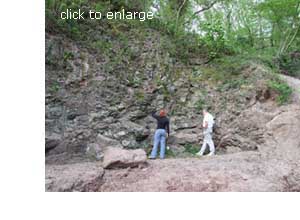
Huntley Quarry Geology Reserve
The Huntley Quarry Geology Reserve was officially opened in 2007, and is the first geology reserve in Gloucestershire. Acker’s Quarry is a small, newly conserved, site, which exposes Triassic Bromsgrove Sandstone sediments, some 237 – 228 million years old. These sediments were probably deposited in a river or estuary that flowed across the deserts of the supercontinent Pangaea. Bright’s Hill Quarry was re-exposed in March 2007 and can be found to the back of Huntley Quarry. Exposed here are Early Silurian (Huntley Hill Formation) siltstones and sandstones, dating from 436 – 428 million years ago. These sediments were probably deposited in a shallow marine environment, which bordered a landmass called the Midlands Platform. Huntley Quarry is the main quarry within the reserve and is a ‘geological gem’.
The Blaisdon Fault has moved in different directions over the course of its long history, displaying several phases of global tectonic plate movements from the closure of the Iapetus Ocean, the formation of the supercontinent ‘Pangaea’, and the subsequent pulling apart of that landmass. These movements can be seen to affect the bedding and sediments, as well as the overall structure of the rocks. There are a number of associated smaller thrust faults seen within the main face, and on the newly exposed ramp section, where the core of a tight fold is also evident. The younger rocks of the Mercia Mudstone Group and Bromsgrove Sandstone rest up against the Huntley Quarry Beds along the Blaisdon Fault, brought down by rifting of the Worcester Basin during the late Palaeozoic - early Mesozoic. For more information on the Huntley Quarry Geology Reserve, contact us directly, or order a Reserve Guide from our Guides and Publications page.
GGT would like to thank our sponsors and supporters of the Huntley Quarry Geology Reserve:
|
To help raise funds for Gloucestershire Geology Trust go to |

| Gloucestershire Geoconservation Trust. Registered Charity Number: 1115272. © 2024 All Rights Reserved. |

